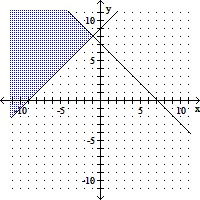Solve the equation.-5q + 1.4 = -28.2 - 1.3q
A. 5.9
B. -33
C. 6.2
D. 8
Answer: D
You might also like to view...
Solve the problem.Identify the incorrect statements about limits.I. The number L is the limit of f(x) as x approaches x0 if f(x) gets closer to L as x approaches x0.II. The number L is the limit of f(x) as x approaches x0 if, for any ? > 0, there corresponds a ? > 0 such that  < ? whenever 0 <
< ? whenever 0 <  < ?.III. The number L is the limit of f(x) as x approaches x0 if, given any ? > 0, there exists a value of x for which
< ?.III. The number L is the limit of f(x) as x approaches x0 if, given any ? > 0, there exists a value of x for which  < ?.
< ?.
A. I and III B. II and III C. I and II D. I, II, and III
Graph each system of inequalities and shade the portion of the graph represented by the solution set..

A. 
B. 
C. 
D. 
Solve the problem.Find an equation for the level curve of the function f(x, y) =  dt that passes through the point
dt that passes through the point  .
.
A. y2 - x2 = 40 B. y2 - x2 = -32 C. y2 - x2 = 32 D. y2 + x2 = 40
Provide an appropriate response.Which function has no vertical asymptote? Why? a. f(x) = 
 b. f(x) =
b. f(x) = 
 c. f(x) =
c. f(x) = 
 d. f(x) =
d. f(x) =
src="https://sciemce.com/media/4/ppg__tttt0508191417__f1q33g7.jpg" style="vertical-align: -17.0px;" /> A. d. No factor from the denominator cancels out. B. b. The numerator is never equal to 0. C. a. The degree of the denominator is larger than the degree of the numerator. D. c. The denominator is never equal to 0.